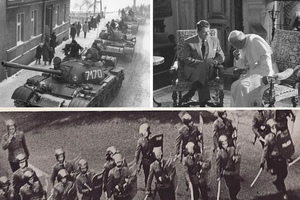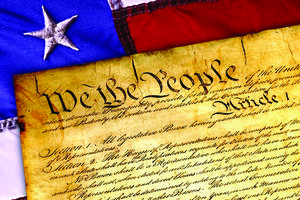John Paul II’s Warning on ‘Final Confrontation’ With the ‘Anti-Church’
COMMENTARY: It seems more likely now that we are indeed facing, as Cardinal Karol Wojtyla said in 1976, the greatest historical confrontation humanity has gone through.

A remarkable gathering took place in the nation’s capital Sept. 26. In two locations, the John Paul II Shrine on the campus of The Catholic University of America and the Ronald Reagan Building on Pennsylvania Avenue, more than 500 people convened for a conference honoring Pope St. John Paul II and President Ronald Reagan and how these two men changed the world for the better.
The event featured speakers worldwide, from those who stood beside the Pope and the president to historians and scholars who have written about them. They ranged from the likes of Peter Robinson, who penned speeches for President Reagan, including the historic Berlin Wall speech, to Monika Jablonska, who has studied the writings of Karol Wojtyla and his poetry and plays. They included Msgr. Slawomir Oder, the postulator for the beatification and canonization of John Paul II, and Arturo Mari, papal photographer for L’Osservatore Romano, who began photographing popes in 1956 with Pius XII.
When I asked Mari if he had a favorite, he didn’t hesitate to say in Italian “Giovanni Paolo.” He gestured to his eyes and said of John Paul II: “You could see saintliness in his eyes.”
But perhaps the most compelling statement of the conference came in the opening remarks by John Lenczowski, who had been a crucial member of the National Security Council (NSC) of Reagan and his chief aide, Judge William Clark. Lenczowski was the director of European and Soviet affairs at the NSC, where he played a significant and underappreciated role in the Reagan effort to undermine the “evil empire” of Soviet Communism. Lenczowski, a faithful American Catholic of Polish lineage, also looked to Pope John Paul II for inspiration.
Lenczowski called attention to an intriguing if not enigmatic admonition by Cardinal Karol Wojtyla made in America in 1976.
That summer, Catholic Americans welcomed this Polish archbishop of Krakow, who, truth be told, was known to very few Americans at the time. It was the nation’s bicentennial, and Philadelphia, the birthplace of the Declaration of Independence in the summer of 1776, had been selected as a rare American city to host an international Catholic Church congress: the 41st International Eucharistic Congress.
The patriotic and pro-American Pole came to the United States for a six-week stay, beginning in Boston. He visited numerous cities, big and small, from Baltimore and Los Angeles to Geyser, Montana, and Stevens Point, Wisconsin.
Amid this tour, Cardinal Karol Wojtyla arrived in Philadelphia for the Eucharistic Congress, which ran Aug. 1-8. The huge event also included a little-known Albanian nun named Mother Teresa. Wojtyla and Mother Teresa were overshadowed by the presence of names more popular at the time: Dorothy Day, Cardinal John Krol and even President Gerald Ford, who attended Mass in the city’s Municipal (JFK) Stadium.
Near the end of his visit, in September, Cardinal Wojtyla shared some striking words. The exact provenance of those words remains elusive to scholars, though they were reported in The Wall Street Journal as having been delivered by the future pontiff in his final speech in the United States before his departure. In one particularly dramatic passage, reprinted by the Journal Nov. 9, 1978 (shortly after he became pope), Karol Wojtyla stated:
“We are now standing in the face of the greatest historical confrontation humanity has gone through. I do not think that wide circles of the American society or wide circles of the Christian community realize this fully. We are now facing the final confrontation between the Church and the anti-Church, of the Gospel versus the anti-Gospel. This confrontation lies within the plans of divine Providence; it is trial which the whole Church, and the Polish Church in particular, must take up. It is a trial of not only our nation and the Church, but, in a sense, a test of 2,000 years of culture and Christian civilization with all of its consequences for human dignity, individual rights, human rights and the rights of nations.”
This was a halting statement. Note the line, “We are now standing in the face of the greatest historical confrontation humanity has gone through.”
What was Cardinal Wojtyla talking about? The Cold War battle against atheistic communism dominated the global scene, but was it genuinely “the greatest historical confrontation” that humanity had undertaken? Were the people of that late-summer 1976 standing in the face of that particular confrontation?
As biographer George Weigel noted in Witness to Hope, “Wojtyla never would have narrowed this ‘confrontation,’ which he insisted ‘lies within the plans of divine Providence,’ to the clash between democracy and communism,” even as communism clearly was “one particularly threatening expression” of that clash in the late 20th century.
Surely there was more at stake in the future pope’s mind at that moment.
Who or what was the anti-Church to which the Polish cardinal was referring? What was the final confrontation? Was this some sort of dire prophecy sensed and not even fully understood by Cardinal Wojtyla at that moment?
As of August-September 1976, the final confrontation with Soviet Communism was indeed at hand — in the coming decade. It was tumultuous, and some blood was shed, including the Holy Father’s when he was shot in May 1981, but communism’s collapse was also considerably less bloody and far more peaceful than anyone anticipated. It seems likewise remarkable that the future pontiff shared this vision in the United States of America at the bicentennial of its birth, one of his few pre-papal visits to the country — the same country that would one day join forces with him, under Ronald Reagan’s leadership, in taking down Soviet Communism and ending the Cold War.
So, again, was the Cold War triumph against atheistic communism circa 1989-91 the final confrontation, or is that showdown still to come?
Here was a statement, a prediction, from a man who not only would be pope, but would be a saint. Was the prophecy met in his lifetime? Was it intended for us beyond his lifetime?
Lenczowski bringing up those words Sept. 26, some four decades after they were delivered, seems particularly poignant. I reported on those words in my book A Pope and a President, published in May 2017; they’ve stuck with me ever since I first read them years ago.
Since then, the problems faced by and within the Church — and arguably posed by an anti-Church — seem to have only gotten worse. They stem from controversies over sex abuse, over corrupted priests and bishops and cardinals, over Church doctrine, over the current Holy Father himself, and, worldwide (especially in the West), over matters once seemingly settled since the dawn of humanity but now openly contested: sexuality, gender, family, marriage and the very nature of humanity.
One of those who stood firmly against this dictatorship of relativism (as Pope Benedict XVI called it) was Cardinal Carlo Caffarra, who helped found the Pontifical John Paul II Institute for Studies on Marriage and Family in 1981. Cardinal Caffarra reminded us of the words of Fatima seer Sister Lucia and of what he called an “anti-creation.” He shared a letter written by Sister Lucia, where she warned that “there will come a time when the decisive confrontation between the Kingdom of God and Satan will take place over marriage and the family.”
We are in quite a confrontation right now. The sheer fullness and explosive breadth of that confrontation today would seem more in keeping with the sweeping, apocalyptic warnings of Cardinal Karol Wojtyla back in 1976.
It seems more likely now, in 2018, that we are indeed facing the greatest historical confrontation humanity has gone through. And the Church and its foes — the anti-Church — are at the center of the battle.
Paul Kengor is professor of political science at Grove City College.
His books include A Pope and a President:
John Paul II, Ronald Reagan and the Extraordinary Untold Story of the 20th Century.
- Keywords:
- paul kengor
- pope st. john paul ii
- ronald reagan

















